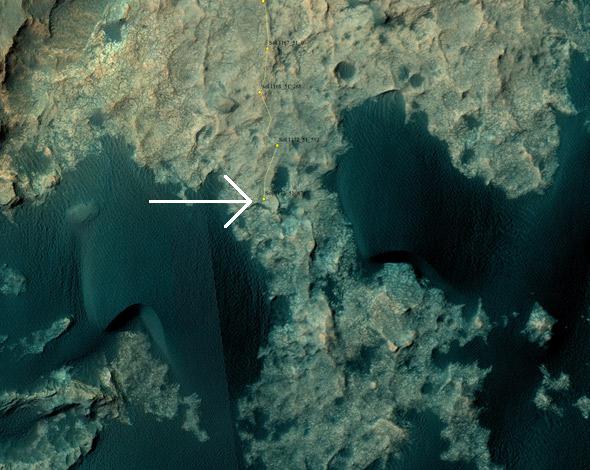Today is the day after American Thanksgiving, considered to be the first shopping day of the Christmas season. Due to the onslaught of eager shoppers to stores, it’s been nicknamed Black Friday.
It’s not restricted to the U.S., though. The Curiosity rover is having its own Black Friday on Mars—in this case, a bit more literally: It’s reached the edge of the Bagnold Dunes, a windswept region in the vast Gale Crater with huge, towering dunes.
The image above was taken Nov. 25, 2015 (also called Sol 1174—a “sol” is a day on Mars, which is about a half-hour longer than an Earth day, and Curiosity has been on Mars for 1175 sols as I write this). Look at it! You can see the flat, grayish rocks in the foreground, and distant hills in the background, but the view is dominated by lush, gorgeous, rippling dunes (check out this mosaic of images showing a much wider angle, too, because wow).
The dunes are dark, likely due to the sand being basaltic—a dark rock created when lava cools. Over billions of years, the exposed Martian basalt has eroded, creating grains of sand that can be blown around by the wind. But not easily!
Mars has an atmosphere, but the pressure at the surface is less than one percent that of Earth. It has winds, but even though they can move rapidly, the air is so thin they don’t have much force to them. Still, it’s enough to blow around the ever-present Martian dust (made mostly of iron oxide, giving it a pinkish-red color … after all, it’s rust!), and finer grained sand particles.
Dune fields litter the surface, but a lot of them are inactive; the wind there isn’t enough to move the sand around. But some fields are active, and the dunes can be seen to move over time. At Bagnold, the dunes migrate at roughly 0.4 meters per year—a little over a foot annually. That’s not much, but it’s measurable.

Photo by NASA/JPL-Caltech/Univ. of Arizona
These dunes are a juicy target for Curiosity. It’s the first time an active extraterrestrial dune field has ever been examined in situ, for one. For another, examining the material will tell scientists on Earth what minerals are in the sand, of course. Measurements from orbit show that there appear to be some minerals located in some parts of the dune field but not in others. Why?
Also, as wind blows the grains it sorts them naturally by size. The distribution of grain sizes around the dunes will indicate how the winds blow, how the grains deposit onto the ground, and more.
The dune field is pretty big, kilometers across. It’s right on the path of the rover, near the foothills on the northwest flank of Aeolis Mons, aka Mount Sharp, Curiosity’s eventual goal. It’ll have to cross the dunes to get to the mountain.
I’m personally thrilled by this shot, and I’ve been waiting for this for a long time. I love dunes on Mars! They’re spectacular, and fascinating.
But more than that, they’re so Earth-like in so many ways. The shapes—horseshoe-shaped barchans dunes, or the more stereotypical transverse dunes in the picture above—look achingly like those on our own fair planet.
Mars was once wetter, warmer, and had thicker air. Now it’s all gone. That’s because of eons of pummeling by the solar wind, the flow of subatomic particles from the Sun. The Earth has a magnetic field, protecting us from that, so we’re still warm and wet, even after 4.56 billion years.
If you want to be thankful for something, be thankful for that. And also that in some places, Black Friday is actually and truly a beautiful thing.
